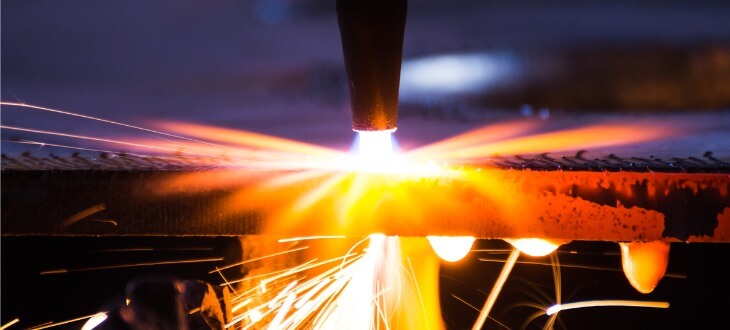Torch cutting, or oxy-fuel cutting, is one of the most popular and established methods for cutting a wide range of metals.
If you are in need of metal, there is a good chance you also need it cut. Whether you are able to cut metal stock yourself or need metal processing services, there are a wide range of methods and equipment to accomplish that task. While newer technologies have broadened the horizons of metal cutting, there are also methods that have been around for decades or longer.
Torch cutting has been around for more than a hundred years, since the invention of the oxygen-acetylene torch in 1903. If you are wondering if this tried and true method is right for your needs, or you just want to learn more about it, the following guide can help.
What is torch cutting?
The oxy-fuel method of torch cutting involves the mixture of compressed oxygen with a gas fuel source that is fed through a specialized cutting torch head. The equipment for torch cutting is similar to oxy-fuel welding. A primary difference is that cutting torches have an oxygen blast lever that accomplishes the actual cutting once the metal has been heated up.
Torch cutting is a highly versatile way to cut a wide array of metals. Although other processes have faster cutting rates and create clean angles more easily, torch cutting is still widely used. Many cutting jobs use torch cutting because it is self-contained, doesn’t need an independent electricity source, and has a relatively low investment cost for equipment.
How to Use a Cutting Torch
The main parts of an oxy-fuel torch cutting setup are:
- Separate gas cylinders containing oxygen and the fuel gas, often fixed to a wheeled trolley
- Pressure regulators to ensure an even flow of the oxygen and fuel source
- Two hoses to transfer oxygen and fuel to the torch
- A specialized cutting torch, which typically has an oxygen blast trigger, an extra pipe, and a differently angled nozzle with multiple jets to accomplish both heating and cutting
First, the cutter will use the torch to heat the metal being cut to ignition temperature, which usually has a cherry red appearance. The next step is engaging the oxygen blast trigger, which creates a jet of pressurized oxygen that ignites and oxidizes the cut area, separating the metal. The runoff from the cut will create a slag that must be chipped away during the process to produce a clean finished edge.
Due to the high heat, light, chemicals, and pressure involved, safety is extremely important when performing any torch cutting operation. The equipment must be inspected regularly to ensure there are no leaks and that proper pressure is maintained. Cutters must also wear protective clothing and equipment, including goggles to protect the eyes from flashes and sparks.
Types of Cutting Torch Fuels
Different fuels can be used for torch cutting, with primary differences being the cost of the fuel and the temperature flame they create. The most common fuels for torch cutting include:
- Acetylene: By far the most widely used gas due to its ability to create a high temperature flame, although it is generally more costly than other fuels.
- Propylene: This gas is often used in production cutting with an injector torch. A major advantage is longer cleaning intervals for the tip.
- Gasoline: A low-cost alternative to acetylene that can produce similar results.
- Hydrogen: Can be used at a higher pressure than some other gasses, such as acetylene, and creates a clean flame that is often used for cutting aluminum.
- Methylacetylene-propadiene (MAPP) gas: Because it can be used at higher pressure, this type of gas is sometimes used to cut thicker pieces of metal.
Other gasses used for oxy-fuel torch cutting can include propane, natural gas, and diesel fuel.
Advantages of Torch Cutting
The best type of metal cutting for a particular job depends on factors that include the type of metal being cut, the location, the budget, and the ideal timeframe. Oxy-fuel torch cutting can offer the following advantages and benefits:
- Quieter and cleaner than other methods such as angle grinders
- Relatively low effort compared to other non-automated methods
- Lower equipment costs compared to other methods such as plasma cutting
- Can be used on non conductive metals and is often better for thicker pieces of metal
- Highly portable, self-contained, and does not require an electrical source
Torch cutting does require a longer warm up time than other cutting methods, and creating clean lines can take some skill and practice. Another concern with torch cutting can be warping of thinner metals due to the wideness of the area being heated.
Visit Tampa Steel & Supply for Quality Metal and Metal Processing Services
Do you need metal supplies and processing? The experienced professionals at Tampa Steel and Supply are here to help. We stock an extensive list of steel products for whatever project you need to tackle. Our commitment is to provide the highest level of service to our customers. Give us a call today to learn more, or stop by our beautiful Tampa showroom.
At Tampa Steel & Supply, our customers are the strength of our business. We are dedicated to delivering quality products and services, and people-focused customer service. We’re here to help you every step of the way and can assist you with any metal processing service you need!
Request a Quote Online
Or Call Tampa Steel & Supply at (813) 241-2801

